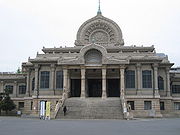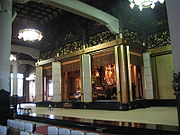
Tsukiji Hongan-ji
Encyclopedia

Jodo Shinshu
, also known as Shin Buddhism, is a school of Pure Land Buddhism. It was founded by the former Tendai Japanese monk Shinran. Today, Shin Buddhism is considered the most widely practiced branch of Buddhism in Japan.-Shinran :...
Buddhist
Buddhism
Buddhism is a religion and philosophy encompassing a variety of traditions, beliefs and practices, largely based on teachings attributed to Siddhartha Gautama, commonly known as the Buddha . The Buddha lived and taught in the northeastern Indian subcontinent some time between the 6th and 4th...
temple located in the Tsukiji
Tsukiji
Tsukiji is a district of Chūō, Tokyo, Japan, the site of the Tsukiji fish market. Literally meaning "reclaimed land," it lies near the Sumida River on land reclaimed from Tokyo Bay in the 18th century, during the Edo period....
district of Tokyo
Tokyo
, ; officially , is one of the 47 prefectures of Japan. Tokyo is the capital of Japan, the center of the Greater Tokyo Area, and the largest metropolitan area of Japan. It is the seat of the Japanese government and the Imperial Palace, and the home of the Japanese Imperial Family...
, Japan
Japan
Japan is an island nation in East Asia. Located in the Pacific Ocean, it lies to the east of the Sea of Japan, China, North Korea, South Korea and Russia, stretching from the Sea of Okhotsk in the north to the East China Sea and Taiwan in the south...
.
Tsukiji Hongan-ji's predecessor was the temple of Edo-Asakusa Gobo (江戸浅草御坊), built in Asakusa
Asakusa
is a district in Taitō, Tokyo, Japan, most famous for the Sensō-ji, a Buddhist temple dedicated to the bodhisattva Kannon. There are several other temples in Asakusa, as well as various festivals.- History :...
in 1617 at the behest of the 12th monshu
Monshu
The Monshu , or keeper of the gate is a term sometimes used in Japanese Buddhism to denote the head of a monastery, as in the case of Jōdo Shū and Tendai Buddhism, but in the case of the Nishi Honganji sub-sect of Jōdo Shinshū Buddhism, it refers to the spiritual leader of the sect, and direct...
, Junnyo Shōnin.
The temple burned during a city-wide fire in 1657, and the shogunate refused to allow it to be rebuilt in Asakusa due to a prior project there. Instead, the temple was moved to a new parcel of land being reclaimed by the Sumida River
Sumida River
The is a river which flows through Tokyo, Japan. It branches from the Arakawa River at Iwabuchi and flows into Tokyo Bay. Its tributaries include the Kanda and Shakujii rivers....
—today's Tsukiji. This land was said to have been reclaimed by Jodo Shinshu
Jodo Shinshu
, also known as Shin Buddhism, is a school of Pure Land Buddhism. It was founded by the former Tendai Japanese monk Shinran. Today, Shin Buddhism is considered the most widely practiced branch of Buddhism in Japan.-Shinran :...
followers themselves who lived at nearby Tsukudajima. The name Tsukiji comes from the kanji
Kanji
Kanji are the adopted logographic Chinese characters hanzi that are used in the modern Japanese writing system along with hiragana , katakana , Indo Arabic numerals, and the occasional use of the Latin alphabet...
characters meaning "reclaimed land". This new temple, named Tsukiji Gobo (築地御坊), stood until it was leveled by the Great Kantō earthquake of 1923.
The present Tsukiji Hongan-ji was designed by Chūta Ito of the University of Tokyo
University of Tokyo
, abbreviated as , is a major research university located in Tokyo, Japan. The University has 10 faculties with a total of around 30,000 students, 2,100 of whom are foreign. Its five campuses are in Hongō, Komaba, Kashiwa, Shirokane and Nakano. It is considered to be the most prestigious university...
and built between 1931 and 1934. It is noted for its unique architecture, influenced by temples in South Asia
South Asia
South Asia, also known as Southern Asia, is the southern region of the Asian continent, which comprises the sub-Himalayan countries and, for some authorities , also includes the adjoining countries to the west and the east...
.

Pilgrimage
A pilgrimage is a journey or search of great moral or spiritual significance. Typically, it is a journey to a shrine or other location of importance to a person's beliefs and faith...
destination due to its artifacts of Prince Shotoku
Prince Shotoku
, also known as or , was a semi-legendary regent and a politician of the Asuka period in Japan who served under Empress Suiko. He was a son of Emperor Yōmei and his younger half-sister Princess Anahobe no Hashihito. His parents were relatives of the ruling Soga clan, and was involved in the defeat...
, Shinran Shonin, and Shonyō Shōnin. Shonyō Shōnin (1911-2002), the 23rd monshu
Monshu
The Monshu , or keeper of the gate is a term sometimes used in Japanese Buddhism to denote the head of a monastery, as in the case of Jōdo Shū and Tendai Buddhism, but in the case of the Nishi Honganji sub-sect of Jōdo Shinshū Buddhism, it refers to the spiritual leader of the sect, and direct...
is enshrined to the left of the main altar in honor of his contributions to the spreading the Jodo Shinshu
Jodo Shinshu
, also known as Shin Buddhism, is a school of Pure Land Buddhism. It was founded by the former Tendai Japanese monk Shinran. Today, Shin Buddhism is considered the most widely practiced branch of Buddhism in Japan.-Shinran :...
teachings abroad so that followers would not be in "name only".
The temple is adjacent to Tsukiji Station on the Tokyo Metro Hibiya Line
Tokyo Metro Hibiya Line
The is a metro line owned and operated by Tokyo Metro located in Tokyo, Japan. The line was named after the district of Hibiya, under which it passes.-Overview:The Hibiya Line runs between in Meguro and in Adachi...
.
The wake of Hiroaki Shukuzawa
Hiroaki Shukuzawa
was a successful rugby coach of the Japan national rugby union team until now. As a player, he was capped three times by Japan as a scrum-half, and he also advised the Japan Rugby Football Union. He held important posts as a banker also....
was held there on June 22, 2006, and a memorial to popular rock musician Hideto Matsumoto
Hide (musician)
, better known by his stage name hide , was a popular Japanese musician. He was primarily known for his work as lead guitarist of the heavy metal band X Japan from 1987 to 1997...
, better known as hide, can be found in the main hall itself, as the temple was the site of the musician's funerary ceremony in 1998.
See also
- For an explanation of terms concerning Japanese Buddhism, Japanese Buddhist art, and Japanese Buddhist temple architecture, see the Glossary of Japanese BuddhismGlossary of Japanese BuddhismThis is the glossary of Japanese Buddhism, including major terms the casual reader might find useful in understanding articles on the subject. Words followed by an asterisk are illustrated by an image in one of the photo galleries...
.

